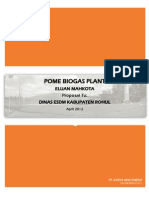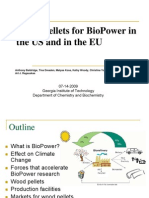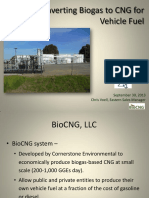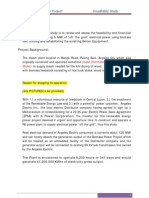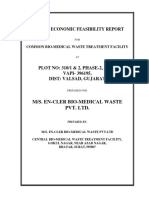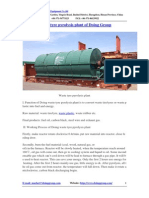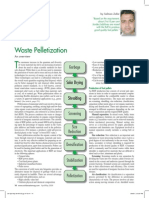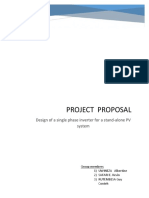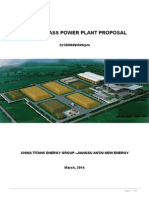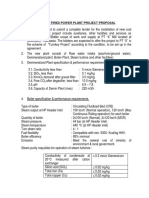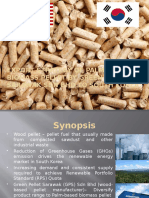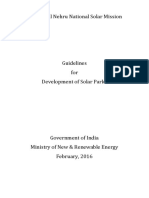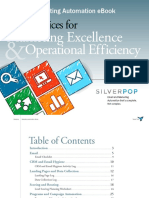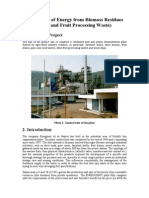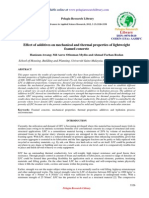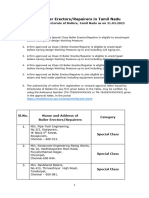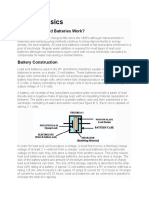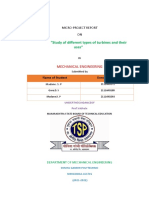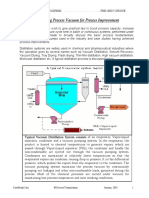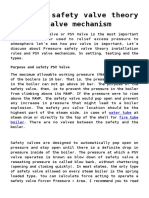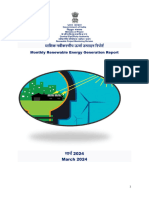Taylor Biomass Energy Proposal
Taylor Biomass Energy Proposal
Uploaded by
Salman LabiadhCopyright:
Available Formats
Taylor Biomass Energy Proposal
Taylor Biomass Energy Proposal
Uploaded by
Salman LabiadhOriginal Description:
Copyright
Available Formats
Share this document
Did you find this document useful?
Is this content inappropriate?
Copyright:
Available Formats
Taylor Biomass Energy Proposal
Taylor Biomass Energy Proposal
Uploaded by
Salman LabiadhCopyright:
Available Formats
PROPOSAL FOR A BIOMASS FUELED POWER GENERATION FACILITY PROJECT PRESENTED TO: GAINESVILLE REGIONAL UTILITIES
DECEMBER 14, 2007
TAYLOR BIOMASS ENERGY, LLC 336 NEELYTOWN ROAD MONTGOMERY, NY 12549 845-457-4021
WWW.TAYLORBIOMASSENERGY.COM
DECEMBER 12, 2007
GRU Biomass Supply RFP No. 2007-135 TAYLOR BIOMASS ENERGY LLC A Biomass Fueled Power Generation Facility Project Proposal For Gainesville Regional Utilities
TAYLOR BIOMASS ENERGY LLC A Biomass Fueled Power Generation Facility PROJECT PROPOSAL FOR GAINESVILLE REGIONAL UTILITIES
PRESENTED TO GRU FROM TAYLOR BIOMASS ENERGY LLC DECEMBER 14, 2007
Page 1 of 26
DECEMBER 12, 2007
GRU Biomass Supply RFP No. 2007-135 TAYLOR BIOMASS ENERGY LLC A Biomass Fueled Power Generation Facility Project Proposal For Gainesville Regional Utilities
Section 1 Executive Summary
General Taylor Biomass Energy LLC (TBE) proposes a Biomass Fueled Power Generation Facility that consists of three basic components as shown in Figure1: A solid waste processing system that process a combination of MSW and raw unadulterated wood waste into recyclables, processed biomass gasification fuel, and residual materials that are not suited for recycle or processed fuel. A biomass gasification process (the Taylor Biomass Gasification Process) that convert the processed fuel into a medium calorific value synthesis gas (syngas). An integrated combined cycle power generation process that uses the syngas as fuel to produce electric power. TBE has developed and refined a sorting and recycling process that can produce a clean feedstock for energy recovery from the abundant residue materials. The sorting and separating process will then be coupled to the Taylor gasification process to produce clean, sustainable energy. This novel gasification process, developed by Taylor Biomass Energy produces a Medium Btu gas having a heating value approximately half that of natural gas (approximately 13 to 17 MJ/Nm3). This unlike the low heating value gas produced in air blown gasifiers, provides the ability to directly substitute for natural gas and can be used as a fuel for combined cycle power generation equipment, or as a synthesis gas for fuel to replace natural gas or the production of chemicals, liquid biofuels, and hydrogen. The Taylor gasification process provides improvements in gasification operations by integrating technologies to reduce issues with ash agglomeration and to provide in-situ destruction of condensable hydrocarbons, an essential element in gas cleanup and environmental performance of the process. The GRU Biomass Fueled Power Generation Facility proposed by Taylor is based on 500 dry tons per day biomass processed fuel (65% MSW and 35% raw unadulterated wood waste) which will generate ~40 gross MW of electric power (~34 to 35 net MW). Ownership Structure TBE Proposes either of two financial and ownership structures for the project:; a Joint Ownership LLC structure between Gainesville Regional Utilities (GRU) and TBE where TBE owns 60% and GRU owns 40% or a take or pay Power Purchase agreement from GRU and TBE owns 100% of the project. TBE favors the joint ownership structure because it would
Page 2 of 26
DECEMBER 12, 2007
GRU Biomass Supply RFP No. 2007-135 TAYLOR BIOMASS ENERGY LLC A Biomass Fueled Power Generation Facility Project Proposal For Gainesville Regional Utilities
allow the project to benefit from the strengths of both companies and also drives the stake holders to work toward mutual goals. Site requirements The site requirements for the 500 DTPD Taylor Biomass Gasification/Power Generation Facility will range between a minimum of ~10 acres up to ~25 acres as shown in figure 4. The final site layout will be defined in the preliminary design phase and will depend upon the exact location on the GRU property and other GRU design requirements. Environmental The control systems that will be installed as a part of the integrated process system will help to reduce emissions both for the power generation product and the liquid product. The criteria pollutants (NOx and CO) are expected to be approximately 0.8 lb / MW produced. This extremely low level of emissions is possible due to the inherently low emissions from the gasification process and gas combustion turbine coupled with the secondary controls installed in the flue gas stream from the process. Byproducts The byproducts from the overall facility consists of material from the solid waste processing process which is not suitable for recycle or processed biomass fuel and ash from the gasification process The material from the solid waste process which is estimated to be ~10% of the incoming 690 tpd of MSW (~70 tpd) will be separated from the MSW stream and sent to a landfill. The ash removed from the flue gas stream in the gasification process is cooled and removed from the process system. The ash is non-leachable and can be sold as a byproduct or disposed of in an ordinary landfill. It is intended to use ash from the unit as a mixing medium in concrete manufacture. The ash generated has an LOI of less than 1% and as such should be very marketable as a concrete additive. Economic Based on an approximate all-in capital cost of $125 MM, an O&M cost (including capital interest and depreciation) of approximately $18.6 MM (see table ) and financing structure, TBE request that the off-take PPA be priced at $70 per Mega Watt hour to be indexed for inflation. Even though the long term capacity factor for the facility is anticipated to be above 90% the PPA to be negotiated will be on an interruptible basis and replacement power and/ or capacity will be dependent upon GRU to provide. The PPA unit pricing on a dollar per kilowatt hour basis does not include the environmental attributes (Renewable Energy Credits), installed capacity, and ancillary services that GRU may want to use or sell in the after
Page 3 of 26
DECEMBER 12, 2007
GRU Biomass Supply RFP No. 2007-135 TAYLOR BIOMASS ENERGY LLC A Biomass Fueled Power Generation Facility Project Proposal For Gainesville Regional Utilities
markets. The all in production costs for the facility should average below that of a new natural gas fired; F-class combined cycle plant.
Section 2 Financial Structure of the Proposal
TBE Proposes either of two financial and ownership structures for the project; a Joint Ownership LLC structure between Gainesville Regional Utilities (GRU) and TBE where TBE owns 60% and GRU owns 40% or a take or pay Power Purchase agreement from GRU and TBE owns 100% of the project. More specifically what is involved is one of the following: A jointly owned LLC structure where each company (TBE and GRU) covers their share (based on % ownership) of the capital cost and initial O&M expenses and there after receiving their prorated share of project profits and cash flows. TBE favors this type structure because it would allow the project to benefit from the strengths of both organizations. Taylor brings experience and expertise in the sorting and separating process of the incoming fuel and the Gasification process and GRU would add experience in the operation and maintenance of the power generation process plus has local contacts to help insure correct employee selection and all other business requirements. This type of structure also drives the stake holders to work toward mutual goals. A Power Purchase Agreement where GRU pays TBE a contractually agreed upon tariff for the electric power on a take or pay basis. This type structure is also beneficial and good for both parties. TBE would design, construct, own, and operate the new facility and sell the electric power to GRU.
Section 3 Technical Information
A. Description of technology and Configuration General TBE proposes a Biomass Fueled Power Generation Facility that consists of three basic components as shown in Figure1: A solid waste processing system that process a combination of MSW and raw unadulterated wood waste into recyclables, processed biomass gasification fuel, and residual materials that are not suited for recycle or processed fuel. A biomass gasification process (the Taylor Biomass Gasification Process) that convert the processed fuel into a medium calorific value synthesis gas (syngas).
Page 4 of 26
DECEMBER 12, 2007
GRU Biomass Supply RFP No. 2007-135 TAYLOR BIOMASS ENERGY LLC A Biomass Fueled Power Generation Facility Project Proposal For Gainesville Regional Utilities
An integrated combined cycle power generation process that uses the syngas as fuel to produce electric power.
MSW
Raw Wood Biomass Taylor Biomass Gasification Process
Electrical Power Combined Cycle Power Generation Process
Solid Waste Process Sorting, Recycle, & Processed Biomass Fuel Production Recycle To Landfill
Processed Fuel
Synthesis Gas Sensible Energy
FIGURE 1 TBE has developed and refined a sorting, separating and recycling process that can produce a clean feedstock for energy recovery from abundant residue materials. The sorting and separating process will then be coupled to the Taylor gasification process to produce clean, sustainable energy. This novel gasification process, developed by Taylor Biomass Energy produces a Medium Btu gas having a heating value approximately half that of natural gas (approximately 400 Btu per scf). This unlike the low heating value gas produced in air blown gasifiers, provides the ability to directly substitute for natural gas and can be used as a fuel for combined cycle power generation equipment, or as a synthesis gas for fuel to replace natural gas or the production of chemicals, liquid biofuels, and hydrogen. The Taylor gasification process provides improvements in gasification operations by integrating technologies to reduce issues with ash agglomeration and to provide in-situ destruction of condensable hydrocarbons, an essential element in gas cleanup and environmental performance of the process. The GRU Biomass Fueled Power Generation Facility proposed by Taylor is based on 500 dry tons per day biomass processed fuel (65% MSW and 35% raw unadulterated wood waste) which will generate ~40 gross MW of electric power (~34 to 35 net MW).
Page 5 of 26
DECEMBER 12, 2007
GRU Biomass Supply RFP No. 2007-135 TAYLOR BIOMASS ENERGY LLC A Biomass Fueled Power Generation Facility Project Proposal For Gainesville Regional Utilities
Recyclable Materials For Sale
By Pass to landfill
Raw Waste Wood
Biomass
Dirt & Rock For Sale
Biomass
Power to Substation
Steam Turbine Generator 15 Mw Power
Condensate Return
Engineered Processed Fuel to Gasifier
Flue Gas
Flue Gas
Flue Gas
~15%
FIGURE 2 See section F Site requirements and layout for information on site layout.
Solid Waste Processing System The proposed Biomass Processing Structure will occupy a footprint of approximately 70,000 SF and process an incoming waste stream consisting of ~690 TPD MSW and ~330 TPD raw unadulterated waste wood (as shown in figure 2). Scaled vehicles will enter this Structure through the entrance as directed by scale house attendants. Within the Biomass Processing Structure, drivers will be directed to the tipping areas of the Structure by signage. The tipping, processing, and loading of materials entering the Biomass Processing Structure (MSW, commercial waste, waste wood, and land clearing debris) will be conducted entirely within the confines of the structure in discrete, conspicuously marked areas.
Page 6 of 26
Flue Gas
Combustion Air Gas Scrubber
Steam
DECEMBER 12, 2007
GRU Biomass Supply RFP No. 2007-135 TAYLOR BIOMASS ENERGY LLC A Biomass Fueled Power Generation Facility Project Proposal For Gainesville Regional Utilities
The Waste Processing system will be comprised of two basic processing lines. Each of the systems will have the capacity to process ~25 tons of waste per hour (~10% excess capacity) and will be operated in tandem, or as separate processes if required by maintenance needs. The system will be scheduled to operate for 2 shifts per day or 16 hrs per day, 5days a week. The Raw wood waste will be delivered as 2 minus chips and will require only minor processing. The sizing of processing equipment and material storage areas within the Processing Structure have been based upon anticipated composition of the incoming MSW stream. It is projected that between 72 and 78% of 690 TPD of MSW received will be utilized as Processed Biomass Fuel, with the remaining portions to be recovered as recyclables or landfilled. 1) Recyclables - Sort and separate recyclable materials, which are not suited for gasification or are better suited for reuse: a. Cardboard; b. Clean paper; c. Ferrous metals; d. Nonferrous metals; e. Rocks or concrete; f. Gypsum; g. Tires; h. Glass; i. Selected Plastics;
2) Processed Fuel Make-Up - The processed fuel primarily consists of the organic component of the MSW feed plus selected plastics: a. Unadulterated Wood: Unpainted dimensional and engineered wood materials except for CCA treated or lead based painted wood. b. Raw wood materials including tree stumps, tree parts, brush, grass clippings, etc. c. Pallets and crating materials except for CCA treated or lead based painted items. d. Non recyclable cardboard, paper and cellulose materials. e. Non recyclable plastics with the exception of PVC plastics. f. Textiles g. Food materials h. Other miscellaneous biomass materials
3) Materials not suitable for gasification or recycle. a. Grit and fines
Page 7 of 26
DECEMBER 12, 2007
GRU Biomass Supply RFP No. 2007-135 TAYLOR BIOMASS ENERGY LLC A Biomass Fueled Power Generation Facility Project Proposal For Gainesville Regional Utilities
b. All hazardous or radio active materials including lead based paints and solvents c. Tires d. Batteries including lead based, lithium and nickel cadmium among others. e. Electronics (not suitable for recycle). f. Glass (not suitable for recycle).
g. Pressurized closed containers. h. Gypsum materials (if not recyclable). i. Soils (if not recyclable). j. Asbestos materials
The key equipment systems that makeup the solid waste process consists of: Screening systems to sort material into three size categories (<3/4, to 3, & over 3) Manual pick lines to remove recyclables, unwanted materials, and provide quality control Magnets and eddy current equipment to remove ferrous and non-ferrous materials. Air separation/classification equipment to sort materials by density Optical sorting equipment for final material classification to insure specification are met Slow speed shedders and final grinders for size classification Transfer conveyors for transferring material throughout the process system The Proposed facilities would be designed to be in compliance with all environmental laws and regulations with the front-end processing system which is customized for the two different waste streams. Taylor Gasification Process Taylor has developed an overall energy recovery system to couple its separation and recycling system with a biomass gasification energy process that can be integrated with a power generation system to provide high efficiency electricity generation. Unlike most other biomass gasification processes, the patent pending Taylor process is not based on starved air combustion, but rather rapidly heats raw biomass in an air free environment to minimize tar formation and create a solid residue that is used as a heat source for the process. Indirectly heated gasification such as the Taylor Process has been demonstrated to be a flexible and reliable method for efficiently producing a medium calorific value gas from biomass based feedstocks. The Taylor gasification process provides improvements over other indirectly heated gasification processes by integrating enhancements to reduce issues with ash agglomeration along with in-situ
Page 8 of 26
DECEMBER 12, 2007
GRU Biomass Supply RFP No. 2007-135 TAYLOR BIOMASS ENERGY LLC A Biomass Fueled Power Generation Facility Project Proposal For Gainesville Regional Utilities
destruction of condensable hydrocarbons (tars), an essential element in gas cleanup and environmental performance of the process.
Significantly fewer emissions are produced in the process because of the relative ease of treating the high energy density, medium calorific value gaseous product. In the process, biomass is indirectly heated using a stream of heated solids to produce a medium calorific value gas (approximately 400 Btu per scf) as is shown schematically below.
Figure 3 In the process, a circulating heat carrying material is used to rapidly heat the incoming biomass and convey unconverted materials from the gasification reactor into an associated combustor. In the gasification reactor, biomass from the sorting and separating section (A) is contacted by the heated heat carrying material sand and steam. No air or oxygen is added so there are no combustion reactions taking place, providing environmental advantages. The biomass is rapidly converted into medium calorific value gas at a temperature of approximately 1500F. Any unconverted residue, along with the cooled Page 9 of 26
DECEMBER 12, 2007
GRU Biomass Supply RFP No. 2007-135 TAYLOR BIOMASS ENERGY LLC A Biomass Fueled Power Generation Facility Project Proposal For Gainesville Regional Utilities
heat transferring material, passes through the gasification reactor and is then separated from the product gas. The product gas continues on to the gas conditioning step and final gas cleanup (specific elements of gas cleanup depend on the end application of the process) while the solids (char) are conveyed into the associated combustion reactor. In the combustion reactor, air is introduced which consumes the char and, in the process, reheats the heat carrier to approximately 1000C. In the combustor all remaining carbon is consumed, resulting in a carbon-free ash. Due to the combustor conditions and the fact that the unconverted material is essentially carbon, emissions are low from this step in the process. The reheated solids are separated from the flue gas and returned to the gasifier. Ash is removed from the flue gas, resulting in a high temperature (1850F) clean gas stream, available for heat recovery. The ash removed from the flue gas is cooled and removed from the process system. The ash is nonleachable and can be sold as a concrete add-mixture or disposed of in an ordinary landfill. The product gas exiting the gasification reactor is conveyed through an innovative gas conditioning module prior to final cleanup. In this unique reduction operation, the product gas is heated to the temperature of the heat carrier returning to the gasification reactor from the combustion reactor, discussed above, (approximately 1850F) which in turn steam reforms these condensable hydrocarbons (tars) into additional useful product gas and reforms the gas to an enhanced compositional makeup. This step eliminates these materials from the gas thus greatly simplifying downstream heat recovery and final gas cleanup for particulate removal. By removing condensables from the product gas, enhanced heat recovery is possible. Compared to systems utilizing a separate, downstream tar removal step, a 40% improvement in recovered sensible energy from the product gas can be realized. The process operates at essentially atmospheric pressure, simplifying the feeding and handling of the incoming biomass. Unlike existing technologies, the Taylor Gasification Process produces a gas which can be substituted for natural gas in many applications, including boilers, heating systems, and advanced power generation processes such as gas turbines and combustion engines. The gas can also be used in combination with natural gas to re-power existing large gas turbine facilities. The Taylor Process generates reduced CO2 emissions, at 98% below conventional coal based plants emission levels and 40% below conventional (direct combustion, steam cycle) biomass plants based upon United Sates Department of Energy (USDOE) lifecycle calculations. In addition, the biomass that is consumed in the process offers an environmentally sound method of waste disposal as compared to landfills or traditional incineration. The Taylor Biomass Energy Solution constitutes both a cost efficient and environmentally conscious renewable power solution.
Page 10 of 26
DECEMBER 12, 2007
GRU Biomass Supply RFP No. 2007-135 TAYLOR BIOMASS ENERGY LLC A Biomass Fueled Power Generation Facility Project Proposal For Gainesville Regional Utilities
The Taylor Biomass Energy Solution is a proprietary, flexible, customizable system that utilizes these residue materials as an energy resource through a combination of up-front recycling and conversion of the majority (the biomass fraction) into highvalue synthesis gas for use as clean, renewable energy. Biomass includes wood, food, paper, paperboard boxes, natural textiles, and other organics. Small quantities of plastics and other similar materials may also be used as input to the Taylor Gasification Process.
Combined Cycle Power Generation Process The electrical power Generation process will be a hybrid 1 x 1 combined cycle plant. (See figure 2) A Combustion Turbine Generator (CTG) rated for approximately 25 MVA gross output will combust the Gasification system product gas in standard combustors. Hot exhaust gas will be routed thru a single-pressure Heat Recovery Steam Generator (HRSG). The HRSG will also supply hot water to the deaerator. Steam from the HRSG primary superheater will be routed to the hot product gas Waste Heat Recovery Boiler (WHRB1) finishing superheater where it will be combined with steam from the WHRB1 primary superheater and with steam from the hot reactor flue gas waste heat recovery boiler (WHRB2) primary superheater. The combined steam flows from the WHRB1 finishing superheater will be sent to the Steam Turbine Generator (STG). WHRB1 will also supply auxiliary steam to the Gasification system thru a control valve at 6000 lb/hr, 50 psig and 400F. The STG will be rated for a 15 MVA gross output. STG exhaust steam will be routed to a condenser where it will be cooled, condensed and collected in a condensate recovery tank. The condensate will then be pumped to the deaerator tank, and from there, to the three boilers HRSG, WHRB1 and WHRB2. All three boilers will be equipped with a blowdown system to include blowdown tanks. The blowdown will be routed to a drain sump. The CTG will include evaporative inlet cooling. All cooling for the CTG auxiliary equipment will occur from air-cooled heat exchangers provided with the CTG. The STG will use auxiliary cooling water for generator cooling (TEWAC) and other auxiliary equipment cooling demands. The auxiliary cooling water system will also cool other Balance of Plant (BOP) equipment. Heat will be removed via a separate, dedicated air-cooled heat exchanger. The HRSG will be equipped with a small duct burner system on the STG, rated at about 1 MW or about 8% of product gas flow. This system will be set up to control product gas flow and pressure conditions in coordination with the CTG fuel demand so as to balance the required fuel flow with the product gas output from the Gasification
Page 11 of 26
DECEMBER 12, 2007
GRU Biomass Supply RFP No. 2007-135 TAYLOR BIOMASS ENERGY LLC A Biomass Fueled Power Generation Facility Project Proposal For Gainesville Regional Utilities
system. The specific regulation criteria from the turbine vendor have not yet been fully defined, but will be established prior to initiation of system start up. The hot product gas waste heat recovery boiler (WHRB1) will receive hot product gas at approximately 1770F and discharge cooled product gas at approximately 250300F to the product gas scrubber. The product gas will be treated to remove certain organics and water. The dry, treated product gas at approximately 100F will be routed to the gas compressors for supplying the CTG. Pressure will then be boosted to 350 psig. Some product gas will also be routed from the gas compressors first stage to the HRSG duct burner system. Two gas compressors will operate in parallel. They will be specified to be multi-stage reciprocating compressors with inter-cooling. These units will raise the product gas supply pressure from near atmospheric pressure to the required discharge pressure to the CTG (approximately 350 psig). The heat from the intercoolers will be recovered in an air preheater which will heat the reactor combustion air prior to it entering the main air heater, and boost the air temperature to approximately 250F. Any excess heat will be removed via the auxiliary cooling water system and its air-cooled heat exchanger. Hot reactor flue gas will be routed thru waste heat recovery boiler (WHRB2) via the air heater. The air heater will cool the flue gas while increasing the temperature of the reactor combustion air from the air preheater to 1100F. Entering WHRB2 at just under 1100F, the flue gas will exit WHRB2 at approximately 350F. It will then combine with the flue gas from the HRSG at approximately 300F and exit the single stack. A single large FD fan will provide reactor combustion air thru the air preheater and air heater before it entering the reactor system itself. Air flow will be controlled by inlet vanes on the fan. Ambient temperatures will vary from winter to summer and affect system performance. This fluctuation has been accounted for and modeled in the heat balances. Additional conditions modeled in the heat balances include duct burner operation and CTG inlet evaporative cooler operation. The overall heat rate for the integrated process is ~7500 Btu/kWh. B. Major Equipment Manufactures (manufactures are typical and changes are possible based on the procurement process during the detail design phase). Solid Waste Processing System Conveying Equipment Systems -- Premiertech Trommel Screen Systems -- Zeno
Page 12 of 26
DECEMBER 12, 2007
GRU Biomass Supply RFP No. 2007-135 TAYLOR BIOMASS ENERGY LLC A Biomass Fueled Power Generation Facility Project Proposal For Gainesville Regional Utilities
Bag Opener Systems -- Matthiessen Air Separation Systems -- Walair Primary MSW Shredders -- SSI Optical Sorting -- Ti-Tech Biomass Shedders -- SSI Cross Belt Magnets -- Premiertech Eddy Current Devices --Premiertech Taylor Gasification Process Gasification Process Feed System -- Orthman Manufacturing Gasification Equipment Modules -- Sanders Bros Fabrication Start up Heater -- Process Combustion Corporation Ash handling System -- AshTech Corporation N2 system -- Air Products Combined Cycle Power Generation Process Waste Heat Recovery Boilers -- Rentech Polishing Scrubber System -- Croll Reynolds SynGas Compression -- Dresser Rand Gas Combustion Turbine -- Solar Turbines HRSG -- Rentech BFW System -- Cleaver Brooks and Nalco Steam Turbine -- Dresser Rand Cooling Tower --GEA Bulk Aqueous Ammonia System -- Roy E Hanson Co. Flue Gas Bag House --Donaldson Torit CEMS -- Monitoring / Solutions C. Fuel supply and requirements including any Backup Fuels D. Net capacity rating E. Indicative net heat rates Recent price increases for various forms of energy along with projected shortages of supply have resulted in renewed interest in alternative fuels. These situations, combined with a desire to provide sustainable energy supplies with minimal environmental impact have resulted in increased emphasis on biomass as an energy source: Gasification Process Output -- One 500 dtpd Taylor Energy Facility can produce approximately 222 MMBTUs of chemical thermal energy as syngas and
Page 13 of 26
DECEMBER 12, 2007
GRU Biomass Supply RFP No. 2007-135 TAYLOR BIOMASS ENERGY LLC A Biomass Fueled Power Generation Facility Project Proposal For Gainesville Regional Utilities
approximately 63 MMBTUs of sensible energy that can be used for additional power production or other heat recovery operations; Electric Power Generation One 500 dtpd plant produces an estimated 40 gross Megawatts and ~35 Net Megawatts of electric power based on combined cycle power generation process. F. Site requirements and layout The site requirements for the 500 DTPD Taylor Biomass Gasification/Power Generation Facility will range between a minimum of ~10 acres up to ~25 acres as shown in figure 4. The final site layout will be defined in the preliminary design phase and will depend upon the exact location on the GRU property and other GRU design requirements.
Page 14 of 26
DECEMBER 12, 2007
GRU Biomass Supply RFP No. 2007-135 TAYLOR BIOMASS ENERGY LLC A Biomass Fueled Power Generation Facility Project Proposal For Gainesville Regional Utilities
G. Projected permitting and construction schedule and in service date A, rolled up, Microsoft project schedule is attached as appendix -. The scheduled key dates for the project are: GRU Short List Binding Proposal Due City Commission Approval Negotiate and Finalize Project Permitting Class A Engineering (preliminary) Power Interconnection Studies Detail Design Equip. and Major Instrumentation Construction Commissioning and Start Up Jan 28, 2008 March 19, 2008 April 14, 2008 April 14, 2008 --- May 9, 2008 June 9, 2008 --- March 27,2009 May 9, 2008 --- October 9,2008 Sept 12, 2008 --- March 26, 2009 August 22, 2008 --- April 23,2009 Sept 12, 2008 --- October 8, 2009 March 30, 2009 --- March 26,2010 Jan 29, 2010 --- July 23, 2010
The facility will be in service by third quarter, 2010 after commissioning and start up is complete. The financial ProForma is based on the following facility operating capacities; 75% the first year, 85% the second year, 92% the third year, and 92% the remaining years of service. H. Dispatchability of the project, including facility limitations The basis of the Taylor Biomass Energy proposal is a base loaded power generation facility which produces approximately 35 net Mw on a 24 hour per day 7 day a week schedule. The Taylor Biomass Gasification Process operates at high temperatures and is not designed to be cycled to follow electric load requirements. The equipment vessels in the process unit as well as the ductwork are refractory lined and thermal excursions that result from following load accelerate derogation of the refractory. Operation of the unit calls for bringing the unit up to full load capacity and maintaining this output level 24x7. The range in percent operation shown in the above section is based on availability associated with maintenance issues during the first three years of operation and is not meant to indicate any load following parameters. The Facility will operate at 92 % availability after the first three years. I. Environmental Characteristics and Emission Rates Reduction of Greenhouse Gases Landfills themselves contribute to environmental deterioration as the organic material contained in these wastes composts. Emissions of greenhouse gases from landfills
Page 15 of 26
DECEMBER 12, 2007
GRU Biomass Supply RFP No. 2007-135 TAYLOR BIOMASS ENERGY LLC A Biomass Fueled Power Generation Facility Project Proposal For Gainesville Regional Utilities
amount to approximately 2.5 pounds for every pound of carbon in the landfill. The emission of these greenhouse gases contributes significantly to the environmental deterioration as a large fraction of the gases emitted is methane. Methane has a global warming potential (GWP) 21 times that of carbon dioxide, the major component in greenhouse gases. Over 75% of the methane emissions in the environment originate from MSW decomposition in landfills. By converting the organic material into sustainable energy, these emissions can be virtually eliminated, resulting in significant reductions in greenhouse gas emissions. By implementing the integrated Taylor Biomass Energy Solution for the proposed project alone, over 135 thousand tons of greenhouse gases can be eliminated from the atmosphere (expressed as CO2 equivalents) by utilizing MSW derived biomass along with other woody biomass sources. When compared to conventional approaches to energy recovery from residue derived fuels, other environmental problems caused by the inherent properties of the technologies themselves arise. In incineration and direct combustion, for example, emissions of criteria pollutants such as nitrogen oxides (NOx), carbon monoxide (CO), particulates, and volatile organics (VOCs) can be quite high due to the process conditions found within these conversion systems. Depending on the contaminants fed along with the residual materials, sulfur oxides (SOx) can also be formed, even though sulfur is typically a contaminant found only at very low levels in biomass. Other more hazardous materials such as dioxins can be produced from chlorine containing species in the incoming fuel. Gasification can improve the situation by converting the incoming material into a combustible gas that can be cleaned to remove contaminants such as nitrogen containing compounds (preventing fuel bound nitrogen producing NOx), sulfur compounds (reducing SOx by removal of H2S from the product gas), and particulates prior to energy recovery improving overall process emissions. Furthermore, by incorporation of advanced NOx reduction technologies such as SCR systems, emissions from the proposed IGCC system will be substantially lower than required in non-attainment areas. Projected Emissions from Integrated System The control systems that will be installed as a part of the integrated process system will help to reduce emissions both for the power generation product and the liquid product. The criteria pollutants (NOx and CO) are expected to be approximately 0.8 lb / MWh produced. This extremely low level of emissions is possible due to the inherently low emissions from the gasification process and gas combustion turbine coupled with the secondary controls installed in the flue gas stream from the process. J. Ash and Other Byproducts The byproducts from the overall facility consists of material from the solid waste
Page 16 of 26
DECEMBER 12, 2007
GRU Biomass Supply RFP No. 2007-135 TAYLOR BIOMASS ENERGY LLC A Biomass Fueled Power Generation Facility Project Proposal For Gainesville Regional Utilities
processing process which is not suitable for recycle or processed biomass fuel and ash from the gasification process The material from the solid waste process which is estimated to be ~10% of the incoming 690 tpd of MSW (~70 tpd) will be separated from the MSW stream and sent to a landfill. The ash removed from the flue gas stream in the gasification process is cooled and removed from the process system. The ash is non-leachable and can be sold as a byproduct or disposed of in an ordinary landfill. It is intended to use ash from the unit as a mixing medium in concrete manufacture. The ash generated has an LOI of less than 1% and as such should be very marketable as a concrete additive. K. Water Use The overall process is expected to use between 150 gallons per minute (gpm) to 240 gpm or 72,530,000 gpy to 116,050,000 gpy of water makeup based on mainly climatic conditions. The majority of the makeup water goes to the cooling tower which used mainly to condense the low pressure steam exiting the steam turbine. As the process is a net producer of water (approximately 30 to 35 gallons per minute), all additional process requirements are made up by treated and recycled water within the process. The proposed system will utilize the required brine concentrator for process discharges. ??? L. Electrical interconnection requirements The Taylor Biomass energy proposal will tie the output of the plant into the existing Deerhaven site facilities at 138 Kv. The nominal output is approximately 35Mw so existing system capabilities will not be exceeded. Output generator voltage levels will be in the 13.8 Kv range and therefore step up transformation will be needed to accommodate the facility. System protection will be dependent upon interconnection requirements at the Deerhaven site and short circuit, stability, and thermal studies will have to be completed prior to finalizing on a system design. Based upon the physical configuration of the system the output from the Taylor substation may be connected into a line tap or directly into a substation or switching station. Because of the size of the facility a major facility Federal Energy Regulatory Commission interconnection filing will have to be made and based upon the final nature of the power purchase agreement a filing to sell at market base rates along with an exempt wholesale generation application may be required. A supply of natural gas to the facility will be required for unit start up and may also be used as a back up source of supply for the combined cycle facility operation during maintenance or contingencies in general. The operation has limited requirement for make up water and Deerhaven site capabilities are more than adequate to meet plant requirements.
Page 17 of 26
DECEMBER 12, 2007
GRU Biomass Supply RFP No. 2007-135 TAYLOR BIOMASS ENERGY LLC A Biomass Fueled Power Generation Facility Project Proposal For Gainesville Regional Utilities
M. Readiness and Reliability of the proposed technology Indirectly heated gasification such as the Taylor Process has been demonstrated to be a flexible and reliable method for efficiently producing a medium calorific value gas from biomass based feedstocks. The Taylor Biomass Gasification process is derived from several existing indirectly heated gasification technologies with several upgrades and improvements. Each of these technologies indirectly transfers energy (heat) to the biomass fuel using a circulating solid heat transfer medium. The Repotec technology currently in commercial operation in Gussing Austria has demonstrated excellent reliability with demonstrated availabilities in excess of 90% for the last three years. This system is an 8 MW combined heat and power system utilizing Jenbacher engines. Similarly the Silvagas process was demonstrated at Burlington Electric Departments McNeal Station at a biomass throughput of approximately three hundred dry tons per day. This system like the Gussing plant demonstrated 90% availability during the final year of its operation. The Taylor Gasification Process utilizes the same indirect heating method and similar reactor configurations (gasification reactor and combustion reactor) as these commercial scale facilities. The enhancement and primary differentiator between the Taylor technology and the other indirectly heated technologies is the integration of the gas condition reactor into the circulating solid stream as described in section 3A.. Taylor is working on several opportunities to build biomass gasification/power generation plants. Presently, Taylor anticipates that the first plant will be built at its Montgomery, NY site. As presently planned, this facility would consist of a solid waste processing system, a 300 DTPD gasification process, plus a power island. The project is currently in the final stages of permitting and the preliminary design (PFDs, P&IDs, equipment arrangements, equipment specifications, etc.) is complete. ONeal Engineers and Constructors has provided a EPC contract price and schedule for the project. N. Performance guarantees, warranties, and risk mitigation The proposed Taylor Biomass Fueled Power Generation Facility Project includes several steps taken to provide performance guarantees, warranties, and reduced risk: The project will be executed utilizing an EPC contractor who will provide a guaranteed price and schedule for the design, construction, and support of the startup of the total project. Taylor currently has a relationship with ONeal Engineers and Constructors and plans to use them as the EPC contractor. (www.onealinc.com)
Page 18 of 26
DECEMBER 12, 2007
GRU Biomass Supply RFP No. 2007-135 TAYLOR BIOMASS ENERGY LLC A Biomass Fueled Power Generation Facility Project Proposal For Gainesville Regional Utilities
ONeal will also support the process performance and warranties as provided by the individual equipment and system suppliers. The project will be designed to maximize equipment systems as opposed to individual equipment pieces. Of the three basic components making up the project, the solid waste processing system, the biomass gasification process (the Taylor Biomass Gasification Process), and the integrated combined cycle power generation process, the gasification process has the least operation experience. Therefore, Taylor will negotiate an efficacy insurance policy to insure the quality and quantity of the syngas produced by the gasification process to feed the gas turbine. O. Back up system and fuels A supply of natural gas to the facility will be required for unit start up and may also be used as a back up source of supply for the combined cycle facility operation during maintenance or contingencies in general. P. Fuel Procurement Practices Biomass supplies for the proposed project are expected to come from MSW (approximately 65%) and woody biomass residuals (approximately 35%). The biomass used is, therefore, expected to be sustainable. If additional supplies are required to maintain the required input to the gasification process, additional woody biomass will be purchased from established suppliers. All of this purchased material, if required, will come from forest residues derived from conventional forestry management.
Section 4 Economic Information
A. Capacity offered and all pricing and cost information The Taylor Biomass Fueled Power Generation Facility as proposed will produce ~40 gross Mw and ~35 net Mw. The system will tie the output into the existing Deerhaven site facilities at 138 Kv. Since the nominal output is approximately 35Mw the existing system capabilities will not be exceeded. The proposed facility has an all-in capital cost of approximately $125MM for design, procurement, construction, and startup (including soft cost; general conditions and fees, efficacy insurance, financing fees, transaction costs, capitalized interest, permitting fees and costs, contingency, escalation, etc.) The O&M costs schedule shown below is from year 4. (Selected start because system is operating at designed 92% availability) through year 8 to show rate of change in cost:
Page 19 of 26
DECEMBER 12, 2007
GRU Biomass Supply RFP No. 2007-135 TAYLOR BIOMASS ENERGY LLC A Biomass Fueled Power Generation Facility Project Proposal For Gainesville Regional Utilities
Operating Costs Operating & Maintanance Waste Processing (MSW) "A" Gasification Process "B" Combined Cycle Power Generation Process "C" Total O & M Costs Financing Costs Interest Depreciation Total Financing Costs Total Costs
Year 4 $ 3,275,727 $3,702,602 $2,061,825 $9,040,153 $3,756,844 $6,218,750 $9,975,595 $19,015,747
Year 5 $3,315,824 $3,741,372 $2,114,772 $9,171,968 $3,412,903 $6,218,750 $9,631,653 $18,803,621
Year 6 $3,372,865 $3,780,232 $2,167,488 $9,320,585 $3,046,982 $ 6,204,750 $9,251,732 $18,572,317
Year 7 $3,427,518 $ 3,821,378 $2,224,358 $9,473,255 $2,657,653 $6,204,750 $8,862,403 $18,335,658
Year 8
$3,487,056 $3,862,652 $2,281,059 $9,630,766 $2,247,294 $6,216,750 $8,464,044 $18,094,810
Table 1 TBE plans to finance the facility in the following manner based on a long term commitments for Biomass fuel supply and a off-take PPA.: Project level or facility level debt ~ 55% (12 year term) Tax equity financing of ~25% Sponsor equity (TBE or TBE and GRU) ~20% TBE request that the off-take PPA be priced at $70 per Mega Watt hour to be indexed for inflation. As previously discussed the unit as a whole cannot follow load since much of the piping in the unit as well as the process vessels within the gasification process are refractory lined and thermal excursions that result from following load accelerate derogation of the refractory. Operation of the unit calls for bringing the unit up to full load capacity and maintaining this output level 24x7. Thus most of the remaining pricing information requested in Section 4 and 5 is not applicable in this application. Even though the long term capacity factor for the facility is anticipated to be above 90% the PPA to be negotiated will be on an interruptible basis and replacement power and/ or capacity will be dependent upon GRU to provide. The PPA unit pricing on a dollar per kilowatt hour basis does not include the environmental attributes (Renewable Energy Credits), installed capacity, and ancillary services that GRU may want to use or sell in the after markets. The all in production costs for the facility should average below that of a new natural gas fired; F-class combined cycle plant. TBE proposes to locate the facility on GRU property and will negotiate a lease for the property or possibly purchase the required site. Currently the quoted cost per mega watt hour rate includes leasing the property from GRU.
Page 20 of 26
DECEMBER 12, 2007
GRU Biomass Supply RFP No. 2007-135 TAYLOR BIOMASS ENERGY LLC A Biomass Fueled Power Generation Facility Project Proposal For Gainesville Regional Utilities
The facility will employ approximately 51 full time employees as shown in Table 2 below:
Section 5 Respondent Information
Taylor has more than 40-years of experience in handling solid waste. Since 1987, Taylor created a unique proprietary process for handling C&D waste, recovering gypsum, and processing land-clearing debris and developed markets for the recycled products. Since 1956, Taylor Tree Service, located near Montgomery, N.Y., about 70 miles north of midtown New York City, processed land-clearing debris and turned it into mulch and related products. Taylor became 100% owned by James Taylor in 1984. Around 1985 to 1989, Taylor diversified utility tree care, electric line maintenance to land clearing as a primary service. During 1989, Taylor expanded to land clearing for new homes and business sites as well as highway expansions. Also in 1989, the Neelytown Road Property was acquired to provide a site for recycling material obtained from various site-clearing locations. Rather than burn the wood, brush and trees, Taylor began processing the debris into mulch by grinding and refining the material. Taylor, also, salvaged landscaping trees from 4 to 12 inches in diameter from clearing projects and resold them to new and existing residential and commercial projects.
Page 21 of 26
DECEMBER 12, 2007
GRU Biomass Supply RFP No. 2007-135 TAYLOR BIOMASS ENERGY LLC A Biomass Fueled Power Generation Facility Project Proposal For Gainesville Regional Utilities
Plant Management Personnel People Plant Manager Plant Engineer Plant Admin Safety, Health, & Environ. Manager MSW and Woody Biomass Production Manager Production Supervisors Process Operators Machine Operators Maintenance - Elec/Mech Gasification & Power Generation Operators (2 operators- 4.3 shifts = 8.6) I&C Technican Maintenance Mechanics Production Manager
Total
1 1 1 1
1 2 22 4 4
9 2 2 1
51
Table 2
In 1989, the New York State law changed as a result the definition of C&D waste now included land-clearing debris. Taylor unexpectedly found itself in the C&D business. At this point in time, Taylor began providing simple "dump and pick" recovery from construction waste. Initially, Taylors goal was to remove material that might hurt the tub grinder making the mulch. Subsequently, Taylor developed a new, more technologically advanced mixed C&D sorting and processing facility with a state-of-the-art environmental protection system that minimizes the impact on the local environment. For example, Taylors entire Montgomery site is graded so that the contours of the area decrease toward the center of the site. In other words, the perimeter is the highest point, and the center is the lowest. There is only one inlet for water onto the site, and only one outlet, at the opposite end of the property.
Page 22 of 26
DECEMBER 12, 2007
GRU Biomass Supply RFP No. 2007-135 TAYLOR BIOMASS ENERGY LLC A Biomass Fueled Power Generation Facility Project Proposal For Gainesville Regional Utilities
Taylors environmental monitoring has documented that all leachate water leaving the site is cleaner than what enters the site. In August 2001, Taylor added a gypsum recycling facility. Today, Taylor processes, on average, 300 tons per day of mixed C&D waste in addition to source separated WW (100 tpd), concrete and scrap drywall material. Following the World Trade Center Disaster, Taylor quickly designed, set up, and operated two customized systems that allowed FBI and NYPD investigators to recover even small bits of forensic evidence from over 550,000 tons of debris in nine (9) months operation at the Fresh Kills Landfill located on Staten Island. The US Army Corps of Engineers recognized that historic effort with the 2002 Contractor of the Year award to the team of which Taylor Recycling was a main part. Biographical Information on Management Team Qualifications Taylor Biomass Energy has assembled an experienced team capable of designing, constructing, and operating the integrated facility coupling the Taylor Sorting and Separating process and the Taylor Gasification Process. This team includes Taylor Sorting and Separating (recycling process) and Taylor Biomass Energy (gasification). The key Taylor Biomass Energy LLC staff, Mr. Mark Paisley, VP of Research and Development, Mr. Ralph Corley, VP of Engineering, Mr. Allan Page, Power Specialist, and Mr. Howard Cohen, CFO brings extensive technical and commercial experience to the company. This experience will help insure that the commercial deployment of the system proceeds quickly and effectively. A brief description of each of the companies and bios of key personnel are shown below.
A. Taylor Biomass Energy LLC
Taylor Biomass Energy was formed to develop and commercially implement a novel biomass gasification process. Over an extensive period of evaluation spanning nearly two years, Taylor determined that indirect gasification to produce medium Btu gas could have the biggest commercial impact when converting biomass from residual materials. Key staff such as Mr. Mark Paisley, VP of Research and Development and Mr. Ralph Corley, VP of Engineering was hired to integrate gasification with the Taylor sorting and separating technology. As a part of this effort, and building on the experience of these individuals, significant improvements to conventional indirectly heated gasifiers were identified and
Page 23 of 26
DECEMBER 12, 2007
GRU Biomass Supply RFP No. 2007-135 TAYLOR BIOMASS ENERGY LLC A Biomass Fueled Power Generation Facility Project Proposal For Gainesville Regional Utilities
incorporated in to the overall process concept broadening the applications of the gasification technology and potentially improving the environmental performance. Name/Contact/Address/Telephone/Fax/E-mail Address James W Taylor, Jr., Chief Executive Officer Taylor Biomass Energy LLC 350 Neelytown Road, Montgomery, New York 12459 Telephone - 845-427-4070 Fax 845-427-4090 E-Mail jim.taylor@taylorbiomassenergy.com Ralph Corley, Vice President Engineering and Construction TBE LLC 16 Sea Shore Dr Pensacola Beach, Florida 32561 Telephone 850-932-2009 Fax 850-932-2045 E-Mail ralphcorley@taylorbiomassenergy.com
Key Staff James Taylor, Jr. As Chairman, Jim directs Taylor Recycling development and led the firms transformation from a tree service business into a leading recycler of construction and demolition debris. Jim is an industry visionary with the practical contracting experience to manage projects of any complexity. Jim built a predecessor firm, Taylor Tree, into one of the regions largest land clearing and tree service companies after buying the firm from his father, who founded Taylor Tree in 1956. Taylors reputation for excellent service was well established by the time Jim expanded the firms wood processing and landscape mulch production to dispose of wood from other businesses. Mark Paisley Mr. Paisley, Vice President of Research and Development is internationally recognized as an expert in gasification technologies, specializing in biomass gasification. Mr. Paisley is the inventor of the Taylor gasification process and is inventor or co-inventor of several other gasification processes. He was in charge of the initial development of a biomass gasification process at Battelle Memorial Institute and continued to direct the technical developments on the process at FERCO Enterprises, the licensee of the process. Mr. Paisley has over 35 years of experience with gasification technologies and energy and chemical value recovery from fuel and residue materials. Ralph Corley Mr. Corley has over 30 years of diversified experience in engineering and construction and in operations for various process areas including: gasification, specialty/petrochemical, fiber optics, power, pharmaceuticals, and general manufacturing. Responsibilities have included project management, process and detailed design, construction management, and total engineer/procure/construct (EPC) management. Experience includes taking projects from Page 24 of 26
DECEMBER 12, 2007
GRU Biomass Supply RFP No. 2007-135 TAYLOR BIOMASS ENERGY LLC A Biomass Fueled Power Generation Facility Project Proposal For Gainesville Regional Utilities
project development through conceptual and detail design, construction and installation; to start-up, commissioning, and operation. This includes process development, preliminary and detail design, project cost & schedule control, and project estimating. Projects have ranged from less than $0.5 million to $200 million. Mr. Corley also has operations experience in the chemicals and fiber optics fields. Experience history includes: Business Area Manager/Account Manager/Project Manager for a global engineering/construction firm (Biomass Gasification Program Manager), Vice President and General Manager for a mid-sized engineering, fabrication, and construction firm, Director of Engineering, Construction, and Maintenance for a large Pharmaceuticals firm, and Process Technology Manager for a major Fiber Optics facility. Howard Cohen Mr. Cohen has over 20 years of experience in financial management and corporate strategies. He has served as a senior auditor for international accounting firms in South Africa and New York, and as controller and chief financial officer in the manufacturing, service, and distribution fields. Mr. Cohen directs the financial and operational functions, information management systems, and workflow capabilities to develop, manage, and expand business opportunities for Taylor Biomass Energy. Allan Page works as a consultant to Taylor. He is the principal and founder of A. Page & Associates. He retired after a 32-year career with the Central Hudson (CH) Energy Group, having worked in customer service, engineering, direct supervision, district and divisional level operating management. During his career with CH Energy, Mr. Page held executive/board level positions including membership on affiliate boards and the position of Group President. For many CH Energy affiliates, Mr. Page served as COO and CEO. He is a team builder with extensive work experience in customer service, engineering, operations, market evaluations, and business acquisitions. Mr. Page has been directly responsible for developing new business ventures such as electric generation companies; energy services companies, retail energy supply businesses (gas, electric, oil, propane), and energy trading organizations. Mr. Page has extensive experience in business analysis, building teams, managing people, and organizational development in general. In his graduate work in Industrial Administration, he was fascinated by the study of human motivation, and he has devoted much of his career to understanding and applying the practical aspects of motivating and developing people, teams, and organizations. He has extensive experience in settling union grievances and in negotiating union contracts. Mr. Page has engineering degrees and a master's in industrial administration from Union College in Schenectady, New York. Mr. Page has also been involved in executive programs in management at the Edison Electric Institute and at the University of Michigan. Mr. Page is a licensed professional engineer in the State of New York.
Page 25 of 26
DECEMBER 12, 2007
GRU Biomass Supply RFP No. 2007-135 TAYLOR BIOMASS ENERGY LLC A Biomass Fueled Power Generation Facility Project Proposal For Gainesville Regional Utilities
Description of the financing model for the project. Taylor Biomass energy, LLC (TBE) believes that it will be able to finance the project in the following manner: i. project level debt with a term of 12 years and an indicative interest rate of 8% for about 60% of the total capital required, tax equity financing with an indicative required return of 8%-9% for about 25% of the total required capital. This portion of the finance package will only be available to the project once the project has completed construction and commissioning, sponsor equity from TBE and or GRU for about 15% of the total required capital. we will be able to raise the required 20% mezzanine debt through construction until the project is constructed and commissioned whereby this debt will be retired with the raising of the tax equity financing.
ii.
iii. iv.
This financial model is based on the assumption that there will be long term contracts in place for the waste materials into the project and the off take agreement for the power produced. TBE believes this model will be available to use on the project because we are in negotiations with our banks and equity partners for other similar projects TBE is promoting. Financial Capability of TBE. TBE was formed in 2005 and is currently developing a few similar projects. We are in final negotiations with a major publicly traded company for a significant investment into TBE. We believe that with this capital and the support of our new investor we will be able to raise the necessary equity capital for the project. Respondents qualifications in the supply of energy. A member of the TBE team Allan Page ex CEO of Central Hudson (our local utility) has 30 years plus of experience in the design, delivery and operation of energy supply units, and has been involved in the sale of that supply into the bulk power markets of New York, New England and PJM. Mr. Page was brought onto the team specifically to address these issues. Financial Guarantees. TBE is currently negotiating with a major insurance carrier for an efficacy insurance policy to provide assurances that the quality and quantity of gas supplied to the turbine by the gasification system meets the standard required by the turbine manufacturers.
Page 26 of 26
Taylor Biomass Energy GRU Proposed Project
ID 1 2 3 4 5 6 7 12 13 18 22 23 24 25 27 30 34 38 39 41 44 55 61 62 73 84 Task Name Duration Start Finish 4Q07 10/07 1Q08 1/08 2Q08 4/08 3Q08 7/08 4Q08 10/08 1Q09 1/09 2Q09 4/09 3Q09 7/09 4Q09 10/09 1Q10 1/10 2Q10 4/10 3Q10 7/10 4Q10 10/10
Taylors's Gainesville Project Submitt Proposal GRU Short List Binding Proposal Due City Commision Approval to Negoiate Negioate and finalize Project Financing Permitting Local (City and County State and Federal Engineering Front-End (class A) Design & Cost Estimate Class A Design Package (PFDs, P&IDs, Eq Arr,etc) Solid Waste design Gasification & Power Design Equipment Specs, Data, & Cost B&C Power Interconnection Studies Detail Design Solid Waste Systems design Area A Gasification and Power Areas B&C Equipment & Major Instrumentation Fabrication (Module Construction) Construction Solid Waste Area A Gasification and Power Areas B & C Commissioning and Start Up
681 days 0 days 0 days 0 days 0 days 40 days 70 days 210 days 190 days 210 days 250 days 110 days 110 days 90 days 90 days 50 days 140 days 175 days 120 days 175 days 280 days 160 days 260 days 225 days 260 days 85 days
Fri 12/14/07 Fri 12/14/07 Mon 1/28/08 Wed 3/19/08 Mon 4/14/08 Mon 4/14/08 Fri 5/9/08 Mon 6/9/08 Mon 6/9/08 Mon 6/9/08 Fri 5/9/08 Fri 5/9/08 Fri 5/9/08 Fri 5/9/08 Fri 5/9/08 Fri 8/1/08 Fri 9/12/08 Fri 8/22/08 Fri 9/26/08 Fri 8/22/08 Fri 9/12/08 Fri 11/7/08 Mon 3/30/09 Mon 3/30/09 Mon 3/30/09 Mon 3/29/10
Fri 7/23/10 Fri 12/14/07 Mon 1/28/08 Wed 3/19/08 Mon 4/14/08 Fri 6/6/08 Thu 8/14/08 Fri 3/27/09 Fri 2/27/09 Fri 3/27/09 Thu 4/23/09 Thu 10/9/08 Thu 10/9/08 Thu 9/11/08 Thu 9/11/08 Thu 10/9/08 Thu 3/26/09 Thu 4/23/09 Thu 3/12/09 Thu 4/23/09 Thu 10/8/09 Thu 6/18/09 Fri 3/26/10 Fri 2/5/10 Fri 3/26/10 Fri 7/23/10
Apr 14 '08 Dec 14 '07 Jan 28 '08 Mar 19 '08 Apr 14 '08 Jun 6 '08
Task
Milestone
Rolled Up Task
Rolled Up Progress
External Tasks
Group By Summary
Project: Gainesville draft 12607 Date: Thu 12/6/07
Progress Summary Rolled Up Milestone Split 1 Page 1 Project Summary Deadline
You might also like
- A Slow Death: 83 Days of Radiation Sickness. ISBN 1942993544, 978-1942993544Document23 pagesA Slow Death: 83 Days of Radiation Sickness. ISBN 1942993544, 978-1942993544jolynjackquelined100% (13)
- Feasibility Study of Biomass Power PlantDocument40 pagesFeasibility Study of Biomass Power PlantSuman Ghosh100% (2)
- Paper On Diversification of Power Producer Into Pellet Manufacturing ProcessDocument5 pagesPaper On Diversification of Power Producer Into Pellet Manufacturing ProcessRavi Satyapal100% (2)
- C175 Fuel Inlet CalculationDocument5 pagesC175 Fuel Inlet CalculationlamNo ratings yet
- Business Case Biomass Fuel PelletDocument18 pagesBusiness Case Biomass Fuel Pelletagbuc11100% (2)
- !!!1MW Fengyu ProposalDocument12 pages!!!1MW Fengyu ProposalUmer_Altaf_5934100% (1)
- Biomass Pelleting PDFDocument6 pagesBiomass Pelleting PDFbanapte59100% (1)
- 50MW Solar Thermal DPRDocument8 pages50MW Solar Thermal DPRExergy50% (2)
- Biomass Feasibility StudyDocument51 pagesBiomass Feasibility StudySalli MarindhaNo ratings yet
- Studie Biomass Power Plants EuropeDocument13 pagesStudie Biomass Power Plants EuropeBaris SamirNo ratings yet
- Backbone Microwave Technical Proposal V1.1Document23 pagesBackbone Microwave Technical Proposal V1.1Salman LabiadhNo ratings yet
- Exhibitors ListDocument19 pagesExhibitors Listamit goyalNo ratings yet
- Biomass Feasibility Financial AnalysisDocument8 pagesBiomass Feasibility Financial Analysissmartleo_waloNo ratings yet
- IRENA-ETSAP Tech Brief E21 Biomass Co-Firing - 005 PDFDocument28 pagesIRENA-ETSAP Tech Brief E21 Biomass Co-Firing - 005 PDF조민기100% (1)
- Business PlanDocument34 pagesBusiness PlanSuratman Blanck MandhoNo ratings yet
- Biomass BriquettesDocument9 pagesBiomass BriquettesMeek ElNo ratings yet
- Biomass Energy Project Development Guidelines PDFDocument152 pagesBiomass Energy Project Development Guidelines PDFpecc1 thuydienlaocai100% (2)
- News Brazil Biomass Project InvestmentsDocument126 pagesNews Brazil Biomass Project Investmentsmar4478100% (1)
- Proposal Biogas RohulDocument13 pagesProposal Biogas RohulIman SatriaNo ratings yet
- Renewable Energy in IndiaDocument20 pagesRenewable Energy in IndiabenoypNo ratings yet
- IPP Procedure ConferenceDocument10 pagesIPP Procedure Conferencekongbeng100% (1)
- 25 MW Biomass Plant China - CDMDocument72 pages25 MW Biomass Plant China - CDMLavu Anil Chowdary100% (4)
- Biomass Pellet Firning Final - 2Document38 pagesBiomass Pellet Firning Final - 2amiyamech047858No ratings yet
- Torrified Pellette Manufaturing June 23Document22 pagesTorrified Pellette Manufaturing June 23koustuv mitra100% (1)
- Biomass Biofuels PDFDocument53 pagesBiomass Biofuels PDFmarkgil1990No ratings yet
- Wood Pellets For Biopower in TheusandintheeuDocument30 pagesWood Pellets For Biopower in TheusandintheeuKevin C. BondNo ratings yet
- 49680E Fesibility Report For COGENDocument89 pages49680E Fesibility Report For COGENsamy005No ratings yet
- Converting Biogas To CNG For Vehicle Fuel: September 30, 2013 Chris Voell, Eastern Sales ManagerDocument51 pagesConverting Biogas To CNG For Vehicle Fuel: September 30, 2013 Chris Voell, Eastern Sales ManagerStalinraja DNo ratings yet
- Biomass Energy ResourcesDocument24 pagesBiomass Energy ResourcesDr. Akepati Sivarami ReddyNo ratings yet
- 5 MW Biomass Project - Technical ReportDocument9 pages5 MW Biomass Project - Technical Reportrmanio100% (2)
- Potential Petroleum Revenues For The Government of Kenya: Implications of The Proposed 2015 Model Production Sharing ContractDocument15 pagesPotential Petroleum Revenues For The Government of Kenya: Implications of The Proposed 2015 Model Production Sharing ContractOxfamNo ratings yet
- 27 May 2016 Pre-Feasibility Project Report BMWDocument53 pages27 May 2016 Pre-Feasibility Project Report BMWVishal V Bhagwat100% (2)
- Waste Tyre Pyrolysis Plant of Doing GroupDocument2 pagesWaste Tyre Pyrolysis Plant of Doing GrouppyrolysisoilNo ratings yet
- Pelletization of Municipal Solid WastesDocument2 pagesPelletization of Municipal Solid WastesSalman Zafar67% (3)
- Biomass Briquette: Aramco Project ProposalDocument5 pagesBiomass Briquette: Aramco Project ProposalHeartwell Bernabe Licayan100% (1)
- Wood Pellet Heat GuidebookDocument26 pagesWood Pellet Heat GuidebookSudhakar GanjikuntaNo ratings yet
- 2 Rajiv Aggarwal Bio CNG A Green Alternate To Fossil FuelsDocument28 pages2 Rajiv Aggarwal Bio CNG A Green Alternate To Fossil FuelsGaneshkumar Ambedkar100% (1)
- Project ProposalDocument6 pagesProject ProposalKevin MweneSafariNo ratings yet
- Biomass Pelletization Process PDFDocument14 pagesBiomass Pelletization Process PDFmos3ad2006No ratings yet
- 06 Biomass Presentation NTPCDocument33 pages06 Biomass Presentation NTPCPMG Bhuswal ProjectNo ratings yet
- Biomass BriquettesDocument41 pagesBiomass BriquettesPamarthi Dhruva100% (4)
- 2mw Biomass Gasification Gas Power Plant ProposalDocument10 pages2mw Biomass Gasification Gas Power Plant ProposalimyourscinNo ratings yet
- Design and Development of Briquette Machine For Eco Friendly EnvironmentDocument7 pagesDesign and Development of Briquette Machine For Eco Friendly EnvironmentANIME4LIFENo ratings yet
- Coal Fired Power Plant Project ProposalDocument5 pagesCoal Fired Power Plant Project Proposalsugeng ubel100% (1)
- 150 MW Mega Solar PV Plant at Gujarat Solar Park CharankaDocument14 pages150 MW Mega Solar PV Plant at Gujarat Solar Park CharankaSayari Das100% (2)
- Biomass BriquettingDocument48 pagesBiomass Briquettinggdanon100% (2)
- Board Paper Presentation (Palm-Based Biomass Pellet)Document20 pagesBoard Paper Presentation (Palm-Based Biomass Pellet)Jenny Yap100% (1)
- Biomass - 2022 Proceeding BookDocument30 pagesBiomass - 2022 Proceeding BookMohamed Ait Lefqih100% (1)
- Biomass Power GenerationDocument90 pagesBiomass Power GenerationPrapan KuchontharaNo ratings yet
- Solar Pumps Project Proposal For Rajasthan.Document2 pagesSolar Pumps Project Proposal For Rajasthan.Manoj Kumar AcharyNo ratings yet
- Introduction To BiogasDocument5 pagesIntroduction To BiogasLouis EldertardNo ratings yet
- 02 PDFDocument202 pages02 PDFMai PavillionNo ratings yet
- SWOT AnalysisDocument41 pagesSWOT AnalysisMohamed Tarek Kamar100% (1)
- New Renewable Energy in India: Harnessing The Potential: Export-Import Bank of IndiaDocument175 pagesNew Renewable Energy in India: Harnessing The Potential: Export-Import Bank of Indiakittu99887No ratings yet
- Wood Pellet Final Report CM Nov07Document40 pagesWood Pellet Final Report CM Nov07muji7No ratings yet
- Bioenergy Technology Roadmap For ColombiaDocument112 pagesBioenergy Technology Roadmap For ColombiaLaura JaimesNo ratings yet
- The Pelletization ProcessDocument1 pageThe Pelletization ProcessWAMU885news100% (1)
- Biomass EnergyDocument14 pagesBiomass EnergyJhon Lester KinakinNo ratings yet
- Solar Park GuidelinesDocument51 pagesSolar Park GuidelinesKamranNo ratings yet
- Wood Pellet in FinlandDocument85 pagesWood Pellet in FinlandJoao Minho100% (1)
- Coal-Fired Power Plant Heat Rate Improvement Options, Part 1Document13 pagesCoal-Fired Power Plant Heat Rate Improvement Options, Part 1Ravi Satyapal100% (1)
- Coal-Fired Power Plant Heat Rate Improvement Options, Part 1 - PowermagDocument12 pagesCoal-Fired Power Plant Heat Rate Improvement Options, Part 1 - PowermagRavi Satyapal100% (1)
- ChemEng 2007-Green EngineeringDocument4 pagesChemEng 2007-Green Engineeringsinnue92No ratings yet
- Reciprocating Generator Sets A Viable Choice in Sustainable Energy LEXE0046-01Document9 pagesReciprocating Generator Sets A Viable Choice in Sustainable Energy LEXE0046-01sdiamanNo ratings yet
- Forex e Learn Study Course PDFDocument26 pagesForex e Learn Study Course PDFSalman LabiadhNo ratings yet
- Induction Training Manual Basic PDFDocument36 pagesInduction Training Manual Basic PDFSalman Labiadh50% (2)
- Marketing Automation Best PracticesDocument40 pagesMarketing Automation Best PracticesSalman LabiadhNo ratings yet
- Forex Trading Guide & Tutorial For Beginner: Website: EmailDocument53 pagesForex Trading Guide & Tutorial For Beginner: Website: EmailSalman LabiadhNo ratings yet
- Fruit & Veg Juices Ranjan SharmaDocument26 pagesFruit & Veg Juices Ranjan SharmaSalman LabiadhNo ratings yet
- Production of Energy From Biomass ResiduesDocument4 pagesProduction of Energy From Biomass ResiduesSalman LabiadhNo ratings yet
- Byecold Catalogue V2015Document7 pagesByecold Catalogue V2015Salman LabiadhNo ratings yet
- Manual On The Production of Traditional MozzarellaDocument56 pagesManual On The Production of Traditional MozzarellaSalman LabiadhNo ratings yet
- Hydraform Group With Pictures and ProjectsDocument10 pagesHydraform Group With Pictures and ProjectsSalman Labiadh100% (1)
- Foam ConcreteDocument13 pagesFoam ConcreteSalman LabiadhNo ratings yet
- صناعة الجبن القريشDocument6 pagesصناعة الجبن القريشSalman LabiadhNo ratings yet
- Constructing A Biogas Plant For A Boarding School in Cape CoastDocument30 pagesConstructing A Biogas Plant For A Boarding School in Cape CoastSalman Labiadh100% (1)
- Hydroponic FourrageDocument12 pagesHydroponic FourrageSalman LabiadhNo ratings yet
- ITU-R E-BandDocument10 pagesITU-R E-BandSalman LabiadhNo ratings yet
- كتاب صناعه الزباديDocument9 pagesكتاب صناعه الزباديSalman LabiadhNo ratings yet
- Flanged Linear Valve Pn16: FeaturesDocument4 pagesFlanged Linear Valve Pn16: FeaturesSyed JahangirNo ratings yet
- Cross River 3.5kva SolarDocument1 pageCross River 3.5kva SolarFetuga AbiodunNo ratings yet
- Power Plant Engg 1Document4 pagesPower Plant Engg 1Rangpariya AmitNo ratings yet
- Transparent Solar Panels": Seminar OnDocument26 pagesTransparent Solar Panels": Seminar OnRahul Kullkarni100% (1)
- Manpower Deployment Plan Ot2499Document1 pageManpower Deployment Plan Ot2499becemNo ratings yet
- Servicemanual Del 5Document49 pagesServicemanual Del 5Carlos MelloNo ratings yet
- Approved Boiler Erectors Repairers 310323Document13 pagesApproved Boiler Erectors Repairers 310323ppcl mmcNo ratings yet
- Theory Questions Asked in Mid Sem and CVMU QP - 07072023Document26 pagesTheory Questions Asked in Mid Sem and CVMU QP - 07072023a9157272235No ratings yet
- Sh1 Dhi p0100 M m01 Pid 5301 - Symbol and Legend 1 of 4Document1 pageSh1 Dhi p0100 M m01 Pid 5301 - Symbol and Legend 1 of 4Thanh SonNo ratings yet
- Battery BasicsDocument7 pagesBattery BasicsAnil kumarNo ratings yet
- FMMMicro ProjectDocument12 pagesFMMMicro ProjectGanesh GoreNo ratings yet
- 4 SS Sistemas y Subsistemas (R)Document17 pages4 SS Sistemas y Subsistemas (R)Yhony Gamarra VargasNo ratings yet
- DRRR Module 13Document47 pagesDRRR Module 13timothy.sevillena1307No ratings yet
- Desene Exp. Exclusive 35MIX Export PDFDocument12 pagesDesene Exp. Exclusive 35MIX Export PDFAdrian GologanNo ratings yet
- Design and Economic Analysis of A Stand-Alone PV System To Electrify A Remote Area Household in EgyptDocument5 pagesDesign and Economic Analysis of A Stand-Alone PV System To Electrify A Remote Area Household in EgyptGallant PradikaNo ratings yet
- Case Studies PDFDocument12 pagesCase Studies PDFDhruv BajpaiNo ratings yet
- Pump Troubleshooting Vol - 1Document300 pagesPump Troubleshooting Vol - 1Dozer122100% (5)
- Unloader Valve in Reciprocating Compressor Capacity ControlDocument8 pagesUnloader Valve in Reciprocating Compressor Capacity Controlfri_13th100% (2)
- Lab2 ReviewerDocument28 pagesLab2 ReviewermartiniNo ratings yet
- Intro Compressor Technique Middle East 2021Document12 pagesIntro Compressor Technique Middle East 2021Khaled Al NuaimiNo ratings yet
- SMA1 Boilers 2010finDocument13 pagesSMA1 Boilers 2010finSandep BhatiaNo ratings yet
- Datasheet Luvegi d750d6Document2 pagesDatasheet Luvegi d750d6fernandezwojNo ratings yet
- Pressure Safety Valve Theory and PSV Valve MechanismDocument5 pagesPressure Safety Valve Theory and PSV Valve MechanismmusNo ratings yet
- HRSG Design UpdateDocument38 pagesHRSG Design UpdateShameer Majeed100% (1)
- Renewable Energy India Generation Report-March 2024-CEADocument30 pagesRenewable Energy India Generation Report-March 2024-CEASRINIVASAN TNo ratings yet
- Centrifugal Pump Books PDFDocument1 pageCentrifugal Pump Books PDFyusufNo ratings yet
- 100kva Dieselgenerator Tech. SpecificationDocument3 pages100kva Dieselgenerator Tech. SpecificationElisée AdouNo ratings yet


















